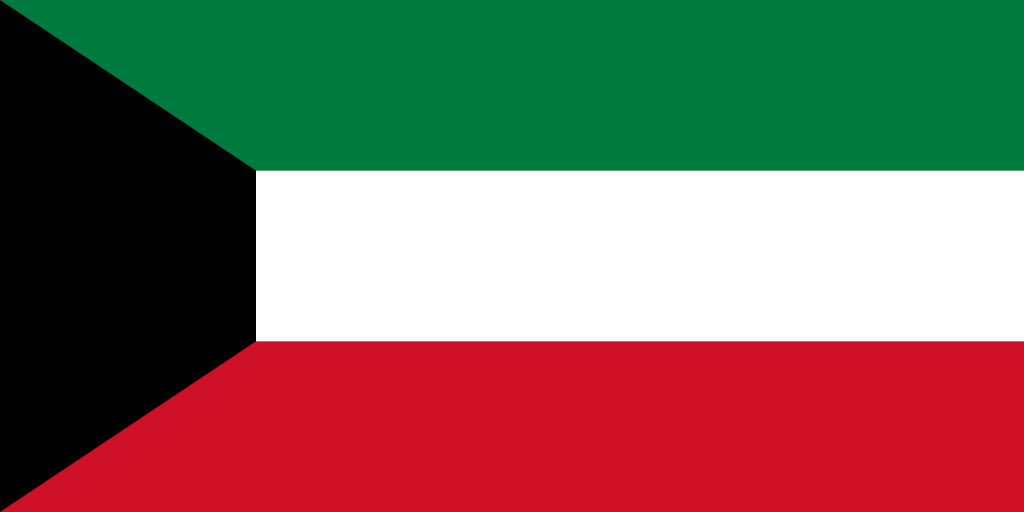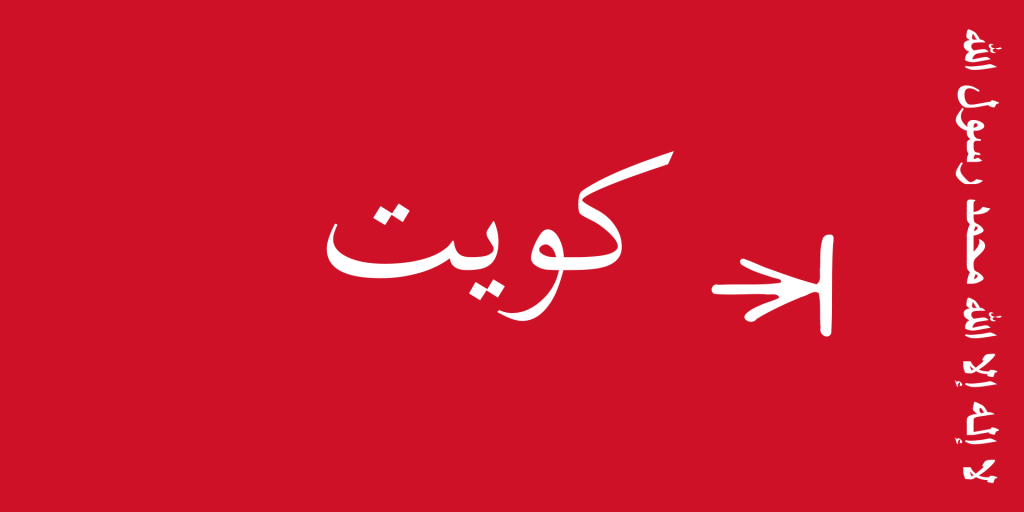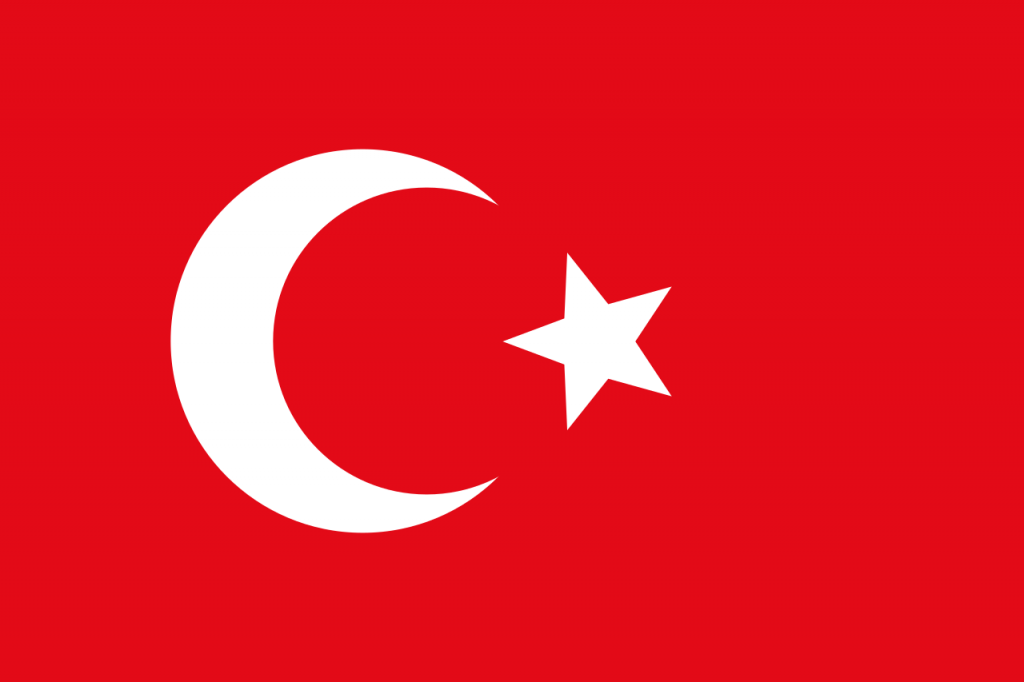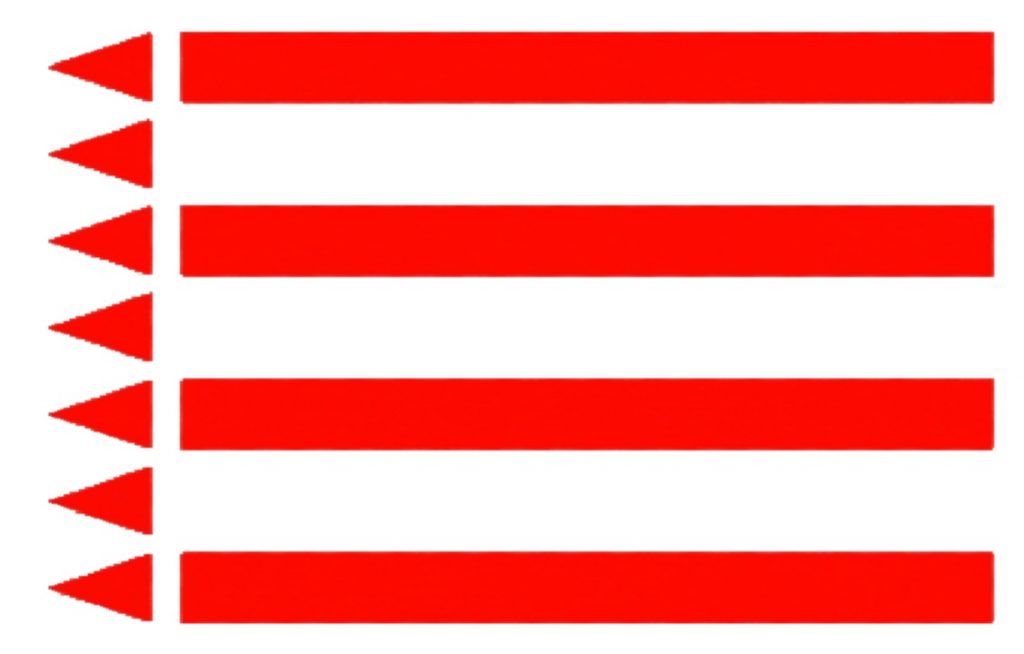Kuwait, at the northern tip of the Arabian peninsula, may be best known for its massive amounts of oil and for being invaded by Ba’athist Iraq in the 1990s, but there’s a lot more to this little emirate than meets the eye. A quick way to gauge the history of a nation is to learn the meaning of its flag and the flag of Kuwait is no exception. The Kuwaiti flag has changed quite a few times over the years, so this here is our guide for what it means and some of the history behind it.
Flag of Kuwait

The present flag may look a bit familiar to others in the region. The horizontal tricolour with a triangle on the left-side is a classic, but this one’s a little different. They’ve decided to go with a trapezoid instead. The reason for this is unclear (at least I couldn’t find out why), but I’d guess it’s primarily to break convention and distinguish this flag from its neighbours. The design and colours originate from the pan-Arab flag which was flown in the Arab revolt in 1917, an event of great significance in Arab history and which can now be seen in flags from Jordan, Palestine, Sudan and elsewhere.
The colours are taken from a poem by Safie Al-Deen Al-Hali, which states “White are our deeds, black are our battles, green are our lands, red are our swords.” You might notice that the colours have also been rearranged a little from the pan-Arab flag, likely as another means of distinguishing it from others while retaining the historical and political significance. This flag of Kuwait was instituted in 1961 upon Kuwait’s independence from Britain, where it had been a protectorate until then.
So alright, this Kuwaiti flag clearly highlights the legacy of pan-Arab ideals, the struggle for Arab independence from foreign rule and links to poetry from the region. That tells us a few basics, but it doesn’t really let us dive deep into Kuwait’s specific history. For that, we’ll need to go back a little.
Flag of Kuwait 1940-1961

Pretty damn different, don’t you think? So let’s start off by looking at the colours. This Kuwaiti flag is pretty much entirely red, with white script. The red banner has long been a popular symbol in Islam, raised by many early Muslim military leaders and being the banner of the Khawarij Islamic sect that had a great deal of power in the Gulf region. This is likely at least part of the reason why many countries in the region, Kuwait included, were flying purely red flags for a long time.
But now, let’s look at the text. The very middle is simply the word ‘Kuwait’ written in Arabic. Pretty simple. Over on the right border, the Shahada is written. The Shahada is a ‘profession of faith’ roughly translating to “There is no god but God, and Muhammad is the Messenger of God.” It’s an oath to the faith and regarded as one of the five pillar’s of Islam. To speak these words with true and honest intentions is regarded by many schools of thought as all it takes to convert to Islam.
And then the other symbol… The arrow pointing towards the line. Well, apparently that’s meant to be a stylized falcon’s claw. Falconry is pretty popular in the region… But what I think this actually links to is the Bani Khalid Emirate, which held great influence over the region around Kuwait from 1669 to 1796. Notice a familiar looking symbol? Perhaps this was meant to evoke a falcon’s claw, but I couldn’t find good answers. Even before them, the same flag was flown by the Jabrids, who held the territory between 1417 and 1524! Either way, the only real difference is a slight redesign and being turned on its side, perhaps trying to evoke that heritage.
What this all tells us is that the flag of Kuwait at this time, when the nation was a Sheikdom protectorate of the British empire, greatly valued its Islamic beliefs and heritage, as was common in the region. It hadn’t quite jumped into the pan-Arab brigade like so many other countries outside of the Gulf. In this region, where the sheikhs and emir’s were much stronger, Islam remained the main source of unity.
The Kuwaiti flags immediately prior to this one were pretty similar. From 1921-1940, the flag was exactly the same but without the ‘falcon’s claw’. From 1914-1921, the Shahada wasn’t there either, so it was just a red banner with the word Kuwait in Arabic script. But before that…
Flag of Kuwait 1871-1914

Well, that’s not the flag of Kuwait! If you don’t know much about flags, you could be forgiven for not seeing why. It’s a red banner after all, with a crescent and star. That’s a major Islamic symbol! But it’s not Kuwait’s, it’s the flag of the Ottoman Empire and indeed, the flag of modern-day Turkey as well. The Al-Hasa Expedition of 1871 saw Ottoman rule come over the region of Kuwait, with the nation becoming a formal vassal of the Ottoman’s in 1875. For that time, their flag looked like this. It’s entirely possible that decades of Ottoman rule influenced the decision to keep using a red flag, though given it’s prior popularity, this isn’t certain.
While Kuwait was subjugated at this time, as a vassal, it maintained a lot of regional autonomy and even became a haven for those trying to escape Ottoman persecution. Due to its stable nature and strategic location, the Ottoman years were actually a time of great economic growth, renowned for its ship-building. The Anglo-Ottoman Convention of 1913 formally acknowledged Kuwait’s status as an autonomous region within the empire, butt even before this, Kuwait had been a protectorate of Britain since 1899. Ottoman rule had largely already disappeared, only to be fully formalized with the collapse of the Ottoman empire after WW1.
Al Sulami Flag (1746-1871)

Perhaps the earliest flag of real relevance to Kuwaiti history is that of the Al-Sulami flag. It was a powerful tribe in the region that crossed between Kuwait, Bahrain, Qatar and parts of Saudi Arabia, often remaining nomadic but providing the earliest settlers and administrators in the region. While not specifically a national flag, it was flown from their warships and from boats during pearl season. Kuwait has historically been a major source of pearls, so this would make sense.
While leaving less of a prominent influence in Kuwait, their flag’s design can still be seen to have influence over the modern flags of Bahrain and Qatar. What is significant is that the ruling family of Kuwait to this very day descends from the Al Bin Ali tribe, who flew this flag. While being the oldest flag and one that isn’t flown much anymore in Kuwait, it’s perhaps the most direct national lineage the nation has.
And that concludes our discussion of the flag of Kuwait! I hope you’ve found it interesting. If you’d like to explore Kuwait for yourself, well good news! YPT actually does tours there! Feel free to check out our landing page and book yourself a trip.





